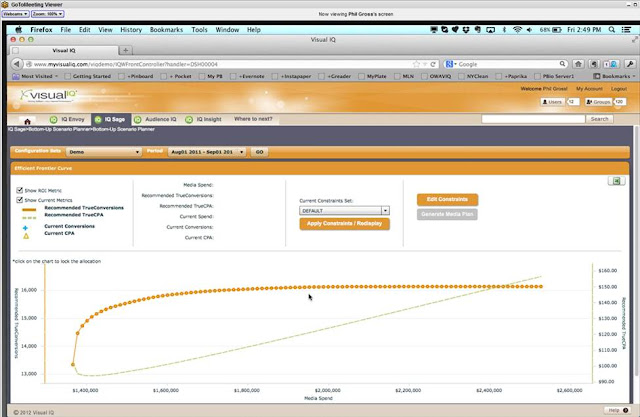As I threatened – I mean, promised – a couple of weeks ago, I’ll be writing about marketing measurement systems over the next month or two. The hottest topic within this segment is probably algorithmic attribution, which uses advanced statistics to calculate the incremental impact of each marketing contact on final results. Unlike marketing mix models, which work with aggregated data such as total TV spend per month, the algorithmic systems start with individual ad impressions. The systems build a history of impressions for each person, identify groups of people with similar histories, and then attribute different results to differences in those histories. For example, there might be two groups of people, one having received three impressions and the other having received the same three plus a fourth. Any difference in outcomes would be attributed to that fourth impression. The actual details are more complicated, but you get the idea.
The advantage of algorithmic attribution is it is based on actual data, rather than arbitrary fractional weights based on someone’s opinion. (I wrote a more detailed critique of fractional attribution back in 2010; I’m pleased to see that algorithmic attribution has become more common since then.) It goes without saying that algorithmic attribution makes more sense than assigning all value to either the first or last marketing touch.
VisualIQ was one of the pioneers of algorithmic attribution, dating back to its founding as Connexion.a in 2005. The company has grown rapidly in recent years. This reflects both greater market interest and, perhaps even more important, expansion of the product to connect directly with ad buying platforms. This makes it easier to convert the system’s findings into profitable marketing results.
Like other attribution systems, VisualIQ must start by assembling data about the client’s advertising programs. The system gathers individual level data either by embedding its own pixel in Web ads, emails, and landing pages, or by importing impression history from other sources. It can stitch together impressions from several different sources to create a unified individual history. It can also import non-individual-level data, such as TV spend, weather, and competitive conditions.
The system can use this data to build two different types of models.
The IQ Envoy module builds “top down” models based on aggregate data; these are similar to traditional marketing mix models but also show the impact of one channel on another (for example, the effect of TV ads on direct mail response). This lets the system estimate the true net contribution to final results of spending in each channel.
Top down models are fairly customized, but Visual IQ has streamlined its process so it can build a new one in six to eight weeks, which is quick for a mix model. and make regular updates. Once the model is built, marketers can easily see the impact of different budget allocations by moving on-screen sliders. Constraints built into the model prevent users from creating scenarios that are unrealistic.
The IQ Sage module builds “bottoms up” models, which use individual-level data. Users can include real-world constraints such as minimum or maximum spend by channel and diminishing returns from higher spending levels. Once the parameters are set, the system generates a graph showing the best possible results for each spending level. Users can pick the level they prefer and have the system generate an optimal media plan. This can be exported to Excel for manual refinement. Or, users can send the plan directly to real time bidding platforms and online ad exchanges for automated execution.
VisualIQ has two additional modules. Insight IQ allows users to explore the data loaded into the system. This is important because marketers may have never seen it all loaded and correlated. Audience IQ shows the demographics of best customers and results for different segments.
As you might imagine, algorithmic attribution needs a large volume of data to build an effective model. VisualIQ has found that clients need an ad budget of at least $5 million per year. Those companies typically gain a 15 to 20% increase in media efficiency.
Cost for VisualIQ depends on the modules used, data volume, number of channels and other variables. Pricing for a system including IQ Sage and IQ Envoy starts around $150,000 per year.





